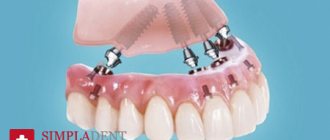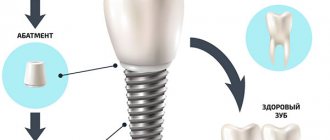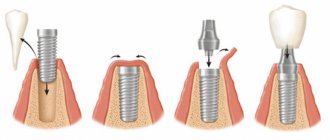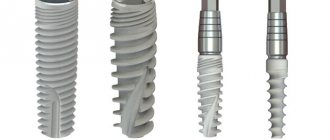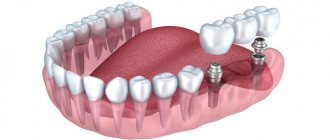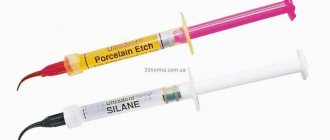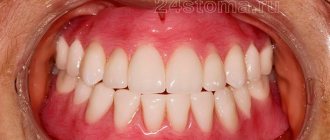Dental implantation is one of the technologies for restoring lost teeth, which is successfully used in modern dentistry. Implantation does not exclude the stage of prosthetics, but it differs from classical prosthetics in that it is not the patient’s teeth that are used as support for the crown or prosthesis, but an implanted dental implant.
An implant, at its core, is an artificial substitute for the root of a lost tooth, which is implanted into the jaw bone and a crown is placed on it. This allows you to qualitatively restore the dentition, recreate its aesthetics and preserve intact neighboring teeth, which would have to be ground down with classical prosthetics.
Dental implantation can be carried out using different technologies - classical, all-on-4, all-on-6, single-stage protocols. We will tell you in detail about simultaneous implantation in this article. After reading the material, you will be able to find out how one-stage implantation differs from classical one, what advantages it has, how the operation is performed and what is the price of one-stage dental implantation in St. Petersburg.
What is single-stage implantation?
Among the wide range of implantation services, one-step dental restoration procedure is becoming increasingly popular.
It involves installing a dental implant into the socket of a newly extracted tooth. This means that the prerequisite for the procedure is the presence of the tooth, followed by tooth extraction and implant placement in one visit. Operation
Medium difficulty
There are contraindications
Doctor's qualifications
High
Conditions under which immediate implantation is not possible
The question of using the technique is decided by the doctor based on the diagnostic results. Simultaneous implantation is not used in the following cases:
- emergency tooth extraction due to injury or acute inflammatory process;
- damage to bone tissue during complex removal - it is important to maintain the integrity of the socket;
- acute inflammatory processes at the root of the tooth - installing an implant under non-sterile conditions can lead to complications;
- general contraindications to implant installation.
What methods of immediate implantation exist?
Representing the installation of a titanium implant into the gum bone tissue, implantation into the socket of an extracted tooth can be of two types:
- After the tooth is removed, an implant is installed, around which the gum tissue is sutured. Subsequent manipulations, namely the installation of an abutment and crown, are performed only after complete healing of the gums and osseointegration of the implant (according to the classic protocol).
- After removal, a monoblock implant is installed, on which a crown is placed.
Work examples
How often do you visit the dentist?
How is it different from the classical method?
The main difference between the technologies is the number of stages. When implementing the classic option, after integrating the implant, a plug is placed on it and the surgical wound is sutured for the period of osseointegration (implantation). And only after this process is completed, the gum is cut again, a gum former is placed for about 2 weeks, then an abutment is attached (an adapter between the artificial root and the supragingival part) and, finally, a permanent crown (“bridge”, complete jaw prosthesis) is fixed. Unlike the classical method, the algorithm involves the simultaneous installation of an implant and a temporary crown.
What are the contraindications to immediate dental implantation?
Despite the popularity of this method of restoring dental aesthetics and functionality, there are a number of reasons why single-stage implantation is impossible.
- Missing tooth. Regardless of whether the tooth was removed two years ago or two weeks ago, it will be impossible to carry out immediate implantation. Only a fresh socket of a barely extracted tooth is suitable for installing a titanium “root”.
- Inflammation of the gum tissue in the area of the tooth that will be removed. The inflammatory process is likely to cause implant failure in the future. In this situation, after removal, complete healing of the hole is necessary and only then can the implant be installed.
- Uncompensated diabetes mellitus.
- Bruxism (teeth grinding that a person cannot control during sleep).
- The period of exacerbation of chronic diseases.
- Heavy smoking.
- Alcoholism.
- Nervous disorders.
There are cases when immediate installation of a dental implant is possible, but immediate loading with a crown is contraindicated. An example is a too traumatic tooth extraction procedure and severe damage to soft tissues.
It is important that an experienced doctor decides on the possibility of installing a crown directly on the implant. This possibility is due to the good condition of the oral cavity, the absence of any problems - carious lesions, problems with the gums, etc. Otherwise, there is a risk of rejection of the “root”. Thus, the accumulation of plaque around injured and unsutured gum tissue is the reason for the occurrence of reimplantitis (inflammation of the bone tissue around a metal implant).
Main indications and contraindications for surgery
The operation is recommended:
- if the patient’s tooth is too damaged and it is recommended for removal;
- with complete loss of a tooth;
- when there is an urgent need to restore a lost tooth;
- if the patient has a sufficient volume of bone tissue to insert the pin, which guarantees its stability and immobility of the root;
- if there is no tissue inflammation (for example, periodontal disease).
Contraindications for simultaneous implantation:
- hole is too big;
- insufficient bone volume;
- soft tissue damage;
- inflammation in the surgical area;
- insufficient oral hygiene;
- There are objective contraindications for immediate loading of the bone.
Also among the contraindications to the protocol are traditional factors, including oncology, tuberculosis, bleeding disorders, cardiovascular diseases, etc.
How is one-stage implantation performed?
The algorithm for performing one-stage dental implantation is as follows:
- An examination of the condition of the oral cavity is carried out. If any problems are identified - carious lesions or inflamed areas of the gums - it is necessary to carry out appropriate treatment.
- Hygienic teeth cleaning is carried out.
- The tooth is removed.
- The hole is cleaned and treated with special compounds.
- The implant is installed.
- If necessary, special bone material is used to increase the strength of implant fixation.
- According to the doctor's decision, an abutment or temporary crown is installed.
All these stages are “fitted” into one dental visit. After which the patient will have to take full responsibility for the healing process and compliance with the rules of the rehabilitation period.
Where to go for treatment
Implantation immediately after tooth extraction has become a common option today to solve the problem. The implant is placed in place of the tooth during the same visit as the extraction. Relatively often, the missing bone around the implant (which, as a rule, is narrower than the root of a natural tooth) must be supplemented with a special biomaterial. In case of extensive bone damage caused by inflammatory processes in the teeth, such treatment is not always possible.
In everyday dental practice, doctors are often faced with the need for removal, including in emergency cases. The method of immediate implantation and, if possible, immediate loading should then be chosen. If, of course, all the requirements are met - there is enough bone tissue, the bone is not too damaged during tooth extraction, etc. Of course, modern dentistry provides other opportunities to help the patient restore extracted teeth. Nevertheless, implantation has many advantages - the highest aesthetic effect and improvement in the patient’s quality of life.
Consult the best specialists in implantology in the capital about dental restoration using a one-step protocol.
| Clinic address | Clinic | Price |
| Dentistry ROOTT |
|
| Moscow, Kolpachny lane, 6, building 4. | Dentistry Sandora |
|
| Dentistry Prosmail.RU |
|
| Moscow, metro station "Butyrskaya", Rustaveli Street, building 15 | Dental Clinic Dention |
|
| Moscow, metro station Barrikadnaya st. Zoologicheskaya, 2, under. 9 | Dentistry DENTAL DREAM |
|
| Moscow, Zvenigorodskoye sh., 7 | Dentistry Implant Expert | Nobel implantation, USA, from 50,000 rubles, Astra Tech implantation, Sweden from 47,200 rubles, OSSTEM Korea - 27,000 rubles |
| Moscow, Bolshoi Sergievsky lane, 5 | Dentistry Viva-dent | Dental implantation depending on complexity: 31,000 - 41,000 rubles per 1 tooth |
| Moscow, st. Molodtsova, 2a | Family discount dentistry | Implantation is carried out using various systems - Astra Tech (Sweden), Ankylos Densply (Germany), Dentium (Korea), the price for 1 restored tooth is from 30,000 rubles. |
| Moscow, Paveletskaya sq., 1 | Dental Clinic Denta VIP | Implantation of the IMPLA system (Germany), OSSTEM (Korea) - from 36,000 rubles. Astra Tech (Sweden) – from 45,000 rubles. |
| Moscow, st. Lyublinskaya, 161 | Dentistry PRESIDENT |
|
Application sent
30-40 minutes
For free
- The doctor will examine you and make a diagnosis.
- You will receive a treatment plan with timing and cost.
- If you are satisfied, you can begin treatment immediately.
Work examples
Restoration of teeth in the upper jaw Case:
A 67-year-old patient came to our dental clinic for dental implantation due to the inability to chew normally, and was also not satisfied with the appearance of the upper dentition. The patient wears a removable denture on the lower jaw, but refused to replace it with a fixed one.
Job:
In the upper jaw, prosthetics on 6 implants were proposed with the installation of a fixed prosthesis “All on 6” the next day.
The patient is satisfied with the work. In just one day, the aesthetics and chewing function of the upper jaw were completely restored.
Doctors:
Dentist surgeon-implantologist Fedorov Roman Nikolaevich
Do you have a similar case?
To make an appointment with a doctor
View all works
